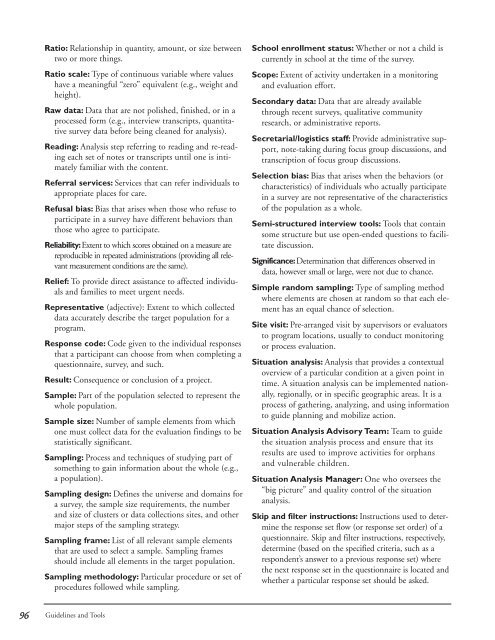Conducting a Participatory Situation Analysis of.pdf - Global HIV ...
Conducting a Participatory Situation Analysis of.pdf - Global HIV ...
Conducting a Participatory Situation Analysis of.pdf - Global HIV ...
Create successful ePaper yourself
Turn your PDF publications into a flip-book with our unique Google optimized e-Paper software.
Ratio: Relationship in quantity, amount, or size between<br />
two or more things.<br />
Ratio scale: Type <strong>of</strong> continuous variable where values<br />
have a meaningful “zero” equivalent (e.g., weight and<br />
height).<br />
Raw data: Data that are not polished, finished, or in a<br />
processed form (e.g., interview transcripts, quantitative<br />
survey data before being cleaned for analysis).<br />
Reading: <strong>Analysis</strong> step referring to reading and re-reading<br />
each set <strong>of</strong> notes or transcripts until one is intimately<br />
familiar with the content.<br />
Referral services: Services that can refer individuals to<br />
appropriate places for care.<br />
Refusal bias: Bias that arises when those who refuse to<br />
participate in a survey have different behaviors than<br />
those who agree to participate.<br />
Reliability:Extent to which scores obtained on a measure are<br />
reproducible in repeated administrations (providing all relevant<br />
measurement conditions are the same).<br />
Relief: To provide direct assistance to affected individuals<br />
and families to meet urgent needs.<br />
Representative (adjective): Extent to which collected<br />
data accurately describe the target population for a<br />
program.<br />
Response code: Code given to the individual responses<br />
that a participant can choose from when completing a<br />
questionnaire, survey, and such.<br />
Result: Consequence or conclusion <strong>of</strong> a project.<br />
Sample: Part <strong>of</strong> the population selected to represent the<br />
whole population.<br />
Sample size: Number <strong>of</strong> sample elements from which<br />
one must collect data for the evaluation findings to be<br />
statistically significant.<br />
Sampling: Process and techniques <strong>of</strong> studying part <strong>of</strong><br />
something to gain information about the whole (e.g.,<br />
a population).<br />
Sampling design: Defines the universe and domains for<br />
a survey, the sample size requirements, the number<br />
and size <strong>of</strong> clusters or data collections sites, and other<br />
major steps <strong>of</strong> the sampling strategy.<br />
Sampling frame: List <strong>of</strong> all relevant sample elements<br />
that are used to select a sample. Sampling frames<br />
should include all elements in the target population.<br />
Sampling methodology: Particular procedure or set <strong>of</strong><br />
procedures followed while sampling.<br />
School enrollment status: Whether or not a child is<br />
currently in school at the time <strong>of</strong> the survey.<br />
Scope: Extent <strong>of</strong> activity undertaken in a monitoring<br />
and evaluation effort.<br />
Secondary data: Data that are already available<br />
through recent surveys, qualitative community<br />
research, or administrative reports.<br />
Secretarial/logistics staff: Provide administrative support,<br />
note-taking during focus group discussions, and<br />
transcription <strong>of</strong> focus group discussions.<br />
Selection bias: Bias that arises when the behaviors (or<br />
characteristics) <strong>of</strong> individuals who actually participate<br />
in a survey are not representative <strong>of</strong> the characteristics<br />
<strong>of</strong> the population as a whole.<br />
Semi-structured interview tools: Tools that contain<br />
some structure but use open-ended questions to facilitate<br />
discussion.<br />
Significance:Determination that differences observed in<br />
data, however small or large, were not due to chance.<br />
Simple random sampling: Type <strong>of</strong> sampling method<br />
where elements are chosen at random so that each element<br />
has an equal chance <strong>of</strong> selection.<br />
Site visit: Pre-arranged visit by supervisors or evaluators<br />
to program locations, usually to conduct monitoring<br />
or process evaluation.<br />
<strong>Situation</strong> analysis: <strong>Analysis</strong> that provides a contextual<br />
overview <strong>of</strong> a particular condition at a given point in<br />
time. A situation analysis can be implemented nationally,<br />
regionally, or in specific geographic areas. It is a<br />
process <strong>of</strong> gathering, analyzing, and using information<br />
to guide planning and mobilize action.<br />
<strong>Situation</strong> <strong>Analysis</strong> Advisory Team: Team to guide<br />
the situation analysis process and ensure that its<br />
results are used to improve activities for orphans<br />
and vulnerable children.<br />
<strong>Situation</strong> <strong>Analysis</strong> Manager: One who oversees the<br />
“big picture” and quality control <strong>of</strong> the situation<br />
analysis.<br />
Skip and filter instructions: Instructions used to determine<br />
the response set flow (or response set order) <strong>of</strong> a<br />
questionnaire. Skip and filter instructions, respectively,<br />
determine (based on the specified criteria, such as a<br />
respondent’s answer to a previous response set) where<br />
the next response set in the questionnaire is located and<br />
whether a particular response set should be asked.<br />
96<br />
Guidelines and Tools















